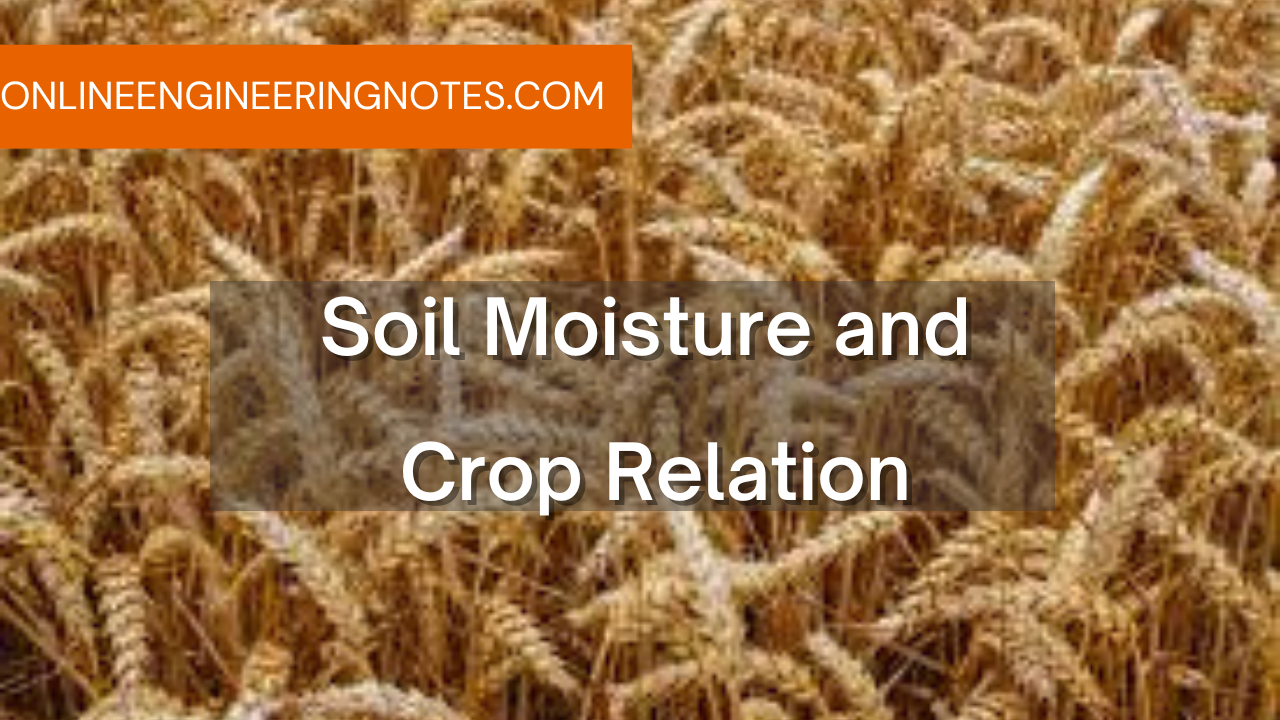1.1 Climate- soil- water- crop (CSWC) relationship:
- Saturation capacity:
Water content of soil when all pores are filled with water.
- Field capacity:
Water content of soil after free drainage has taken place for sufficient period.
- Gravity water:
Rainfall or irrigated water flow down to water table under gravity.
- Capillary water:
Water held by surface tension against gravity.
- Hygroscopic water:
Water that cannot be extracted by plants.
- Soil moisture:
Water above water table.
- Permanent wilting point (PWP):
The water content at which plant can no longer extract sufficient water for growth and wilts up.
- Available moisture content (AMC):
Difference of water content between field capacity and permanent wilting point.
- Readily available moisture content (RAM):
Portion of AMC that is easily extracted by plants.
- Optimum moisture content (OMC):
The water content soil is not allowed to deplete below a certain value.
- Soil moisture deficiency:
Water required to bring soil at a given water content to its field capacity.
Soil moisture irrigation relationship:

Let,
d = Effective depth of root zone
FC = Field capacity
From definition of field capacity,
FC = Weight of water retained in certain volume of soil / Weight of dry soil of same volume
Considering unit area of soil
Weight of dry soil = γd * d
Weight of water retained = FC * γd * d
So, volume of water retained is,
V = (FC * γd * d) / γw
Where,
γw = Unit weight of water
γd = Dry unit weight of soil
1.2 Soil moisture regime: Crop water requirement
- Consumptive use (Cu) or Evapotranspiration:
Defined as the total amount of water used by the plants in transpiration and evaporation from adjacent soil in specified time.
- Potential evapotranspiration (PET):
If sufficient moisture is available to completely meet need of plant.
- Actual evapotranspiration (AET):
Real evapotranspiration occurring in a specific situation.
- Estimation of consumptive use:
Consumptive use is estimated by penman’s equation.
PET = ( A* Hn + Ea * γ) / (A + γ)
Where,
Hn = Net incoming solar radiation or energy expressed in mm of evaporable water per day
A = Slope of saturation vapor pressure versus temperature curve at mean air temperature
Ea = Parameter including wind velocity and saturation deficit in mm/day.
γ = Psychrometric constant = 0.49 mm of Hg/oC
1.3 Factors affecting crop water requirement:
- Crop factor:
- Variety
- Growth stage
- Duration
- Plant population
- Crop growing season
- Soil factor:
- Structure
- Texture
- Depth
- Topography
- Soil chemical composition
- Climate factor:
- Temperature
- Sunshine hour
- Relative humidity
- Wind velocity
- Rainfall
- Agronomic management factor:
- Irrigation method use
- Frequency of irrigation and its efficiency
1.4 Base period, kor period, duty, delta and their relationship.
- Crop period:
Time period that elapses from the instant of its sowing to the instant of its harvesting.
- Base period (B):
- Time period that elapses between first watering of crop after sowing to last watering of crop before harvesting.
- Crop period and base period are taken equal.
- Delta (Δ):
- Total quantity of water required by a crop for full maturity.
- Expressed in mm or cm.
- Duty (D):
- Number of hectares of land irrigated for full growth of a given crop by the supply of 1 cumec water continously during base period.
- Expressed in hectare/cumec.
- Design discharge (Q) = Area (A) / Duty (D)
- Kor watering:
- First watering which is given to a crop when crop is few centimeter high.
- Maximum watering is done.
- Kor period:
Kor watering must be applied within the fixed limited period.
- Kor depth:
Depth of water supplied in the Kor period.
Relationship between duty, delta and base period.
Let, there be a crop of base period B days. Let 1 cumec of water be applied to this crop for B days.
Now, volume of water applied to this crop during base period.
V = ( 1 cumec * B days)
or, V = 1 * 60 * 60 * 24 * B days
or, V = 86400B m3
The quantity of water mature D hectare of land.
So, area irrigated A = 104 D, ha
Total depth of water applied to the field is given by
Δ = Volume / Area = 86400B / 104 D
or, Δ = 8.64B / D , m
or, , Δ = 864B / D , cm
Since design discharge is calculated based on kor depth and kor period.
Kor depth = (864 * Kor period) / Duty , cm
1.5 Command area of irrigation system – GCA, CCA and NCA.
- Gross commanded area ( GCA) :
- Total area bounded within irrigation boundary which can be irrigated without considering the limitation of quality of water available.
- Includes cultivable and uncultivable area like road, ponds, residential area etc.
- Cultural or cultivable commanded area (CCA):
- Includes only cultivable area.
- Divided into:
a. Cultural cultivated area
b. Cultural uncultivated area
- Net commanded area (NCA):
- Cultivable commanded area deducting the area of canal network, supply ditches, bunds constructed in the field.
1.6 Principal crops, their season and water requirement
In irrigation a year is divided into two cropping season:
- Kharif season (Summer)
- Starts from April 1 and ends on 30th September.
- Kharif crops: rice, bajra, maize, cotton, tobacco etc.
- Rice is the most important kharif crop.
- Rabi season (Winter)
- Starts from October 1 and ends on 31st March.
- Rabi crops: wheat, barley, mustard, potatoes etc.
- Wheat is the most important rabi crops.
References:
- WECS (1998), Design Guidelines for Surface Irrigation in Terai and Hills of Nepal, (Vol. I and II)
- Michael, A.M.(2011). Irrigation theory and practice
- FAO(1977). Guidelines for Predicting Crop Water Requirements. FAO Irrigation and Drainage Paper No. 24.

